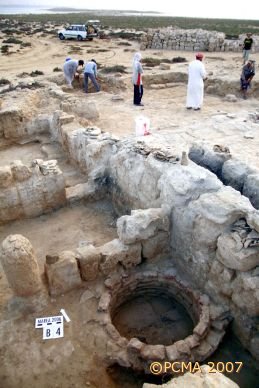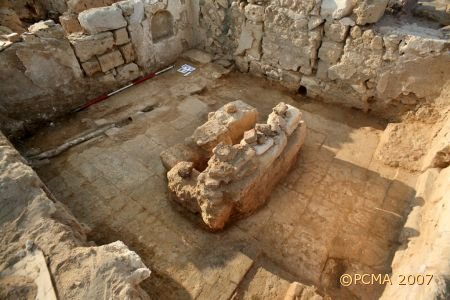Medieval History

Polish archaeologists discovered an unknown baptistery, and a few hundred bronze coins during archaeological work in Marea, a town situated 44 kilometers southwest of Alexandria.
According to Science and Scholarship in Poland, the project, being run by The University of Warsaw's Center of Mediterranean Archaeology and The Archaeology Museum in Kraków has focused their recent efforts on examining the eastern side of the basilica and rooms placed behind the southwestern corner of the building.
While excavating the floors in the basilicas main nave and its northern side nave the archaeologists discovered a baptistery. Its dimension is 4.5 by 2.5 meters and is 1.5 meters high. It is built from large stone blocks.
The archaeologists also discovered a well attached to the baptistery with special holes in its walls for the people who where to clean it. It hasn't been established whether water that was used to baptize people came from the well, from a lake or from another underground source.

The archaeologists are also surprised that the whole construction was rested on a stylobate, they believed the column was removed in order to build the baptistery. The archaeologists also add that the baptistery, which was discovered in 2003, was built in the 5th century A.D., and may have been completed before constructing the main part basilica.
Two giant structures were discovered in the southern nave. They were probably built there to create a small area next to the side entrance to the basilica. Archaeologists discovered fragments of a marble bowl for holy water between them. In the northeastern corner of the basilica archaeologists discovered a camouflaged cellar made up of two rooms, partially rock-hewn. The cellar was full of almost one hundred small water vessels and olive lamps. They also discovered a few hundred bronze coins. Two ditches above the cellar served to ventilate it.
Marea was a bustling port in the early middle ages, and was occupied until the 16th century. Early archaeological digs have discovered shops and a bath, which operated during the 7th and early 8th centuries.
Other available resources with more information about the Marea project:
Marea on Lake Maryut
The Location and Reconstruction of a Byzantine Structure in Marea, Egypt Including a Comparison of Electronic Remote Sensing and Remote Viewing
- Polish Archaeologists Find Unknown Tomb In Egypt
Polish archaeologists have discovered the entrance to a previously unknown tomb during excavation work in Egypt. The discovery was made at the historic necropolis of Saqqara, which had functioned as a burial ground for the Ancient Egyptian capital of...
- More Antiquities Revealed By Thessaloniki Metro
A 4th-century A.D. chapel that may be the oldest Christian place of worship in Thessaloniki was discovered by archaeologists beneath an early Christian basilica, itself unearthed during construction of the Sintrivani metro station in the northern port...
- 12th-century Crusader Fresco To Go On Display In Israel
An enormous Crusader-era fresco that was discovered in Jerusalem will go on display next month at the Israel Museum. At nine meters long and 2.7 meters high, it is the largest painting ever discovered by archaeologists in Israel.... Click here to read...
- Byzantine Bathhouse Found In Syria
Syrian archaeologists have disovered the remains of a bathhouse dating back to the late Byzantine era and the beginning of the Umayyad era. The bath was discovered within a huge architectural bloc, which was likely a palace. Ibrahim Amiri, who heads...
- Medieval Shipyard Discovered On Skye
Evidence of a medieval shipyard has been discovered on the Isle of Skye, which lies in the Inner Hebrides islands of Scotland. Archaeologists have discovered a man made stone quay at Loch na h-Àirde inn the southwest portion of the island, which would...
Medieval History
Byzantine Baptistry discovered in Egypt

Polish archaeologists discovered an unknown baptistery, and a few hundred bronze coins during archaeological work in Marea, a town situated 44 kilometers southwest of Alexandria.
According to Science and Scholarship in Poland, the project, being run by The University of Warsaw's Center of Mediterranean Archaeology and The Archaeology Museum in Kraków has focused their recent efforts on examining the eastern side of the basilica and rooms placed behind the southwestern corner of the building.
While excavating the floors in the basilicas main nave and its northern side nave the archaeologists discovered a baptistery. Its dimension is 4.5 by 2.5 meters and is 1.5 meters high. It is built from large stone blocks.
The archaeologists also discovered a well attached to the baptistery with special holes in its walls for the people who where to clean it. It hasn't been established whether water that was used to baptize people came from the well, from a lake or from another underground source.

The archaeologists are also surprised that the whole construction was rested on a stylobate, they believed the column was removed in order to build the baptistery. The archaeologists also add that the baptistery, which was discovered in 2003, was built in the 5th century A.D., and may have been completed before constructing the main part basilica.
Two giant structures were discovered in the southern nave. They were probably built there to create a small area next to the side entrance to the basilica. Archaeologists discovered fragments of a marble bowl for holy water between them. In the northeastern corner of the basilica archaeologists discovered a camouflaged cellar made up of two rooms, partially rock-hewn. The cellar was full of almost one hundred small water vessels and olive lamps. They also discovered a few hundred bronze coins. Two ditches above the cellar served to ventilate it.
Marea was a bustling port in the early middle ages, and was occupied until the 16th century. Early archaeological digs have discovered shops and a bath, which operated during the 7th and early 8th centuries.
Other available resources with more information about the Marea project:
Marea on Lake Maryut
The Location and Reconstruction of a Byzantine Structure in Marea, Egypt Including a Comparison of Electronic Remote Sensing and Remote Viewing
- Polish Archaeologists Find Unknown Tomb In Egypt
Polish archaeologists have discovered the entrance to a previously unknown tomb during excavation work in Egypt. The discovery was made at the historic necropolis of Saqqara, which had functioned as a burial ground for the Ancient Egyptian capital of...
- More Antiquities Revealed By Thessaloniki Metro
A 4th-century A.D. chapel that may be the oldest Christian place of worship in Thessaloniki was discovered by archaeologists beneath an early Christian basilica, itself unearthed during construction of the Sintrivani metro station in the northern port...
- 12th-century Crusader Fresco To Go On Display In Israel
An enormous Crusader-era fresco that was discovered in Jerusalem will go on display next month at the Israel Museum. At nine meters long and 2.7 meters high, it is the largest painting ever discovered by archaeologists in Israel.... Click here to read...
- Byzantine Bathhouse Found In Syria
Syrian archaeologists have disovered the remains of a bathhouse dating back to the late Byzantine era and the beginning of the Umayyad era. The bath was discovered within a huge architectural bloc, which was likely a palace. Ibrahim Amiri, who heads...
- Medieval Shipyard Discovered On Skye
Evidence of a medieval shipyard has been discovered on the Isle of Skye, which lies in the Inner Hebrides islands of Scotland. Archaeologists have discovered a man made stone quay at Loch na h-Àirde inn the southwest portion of the island, which would...
